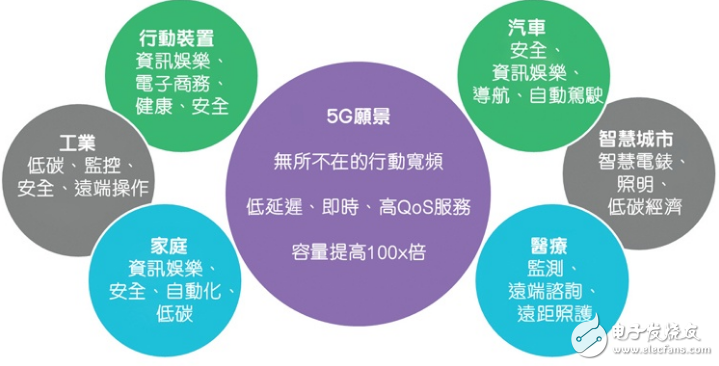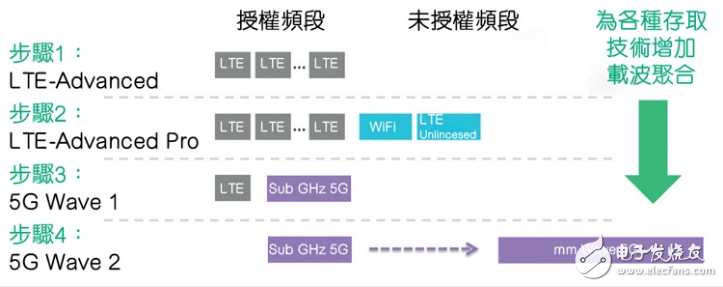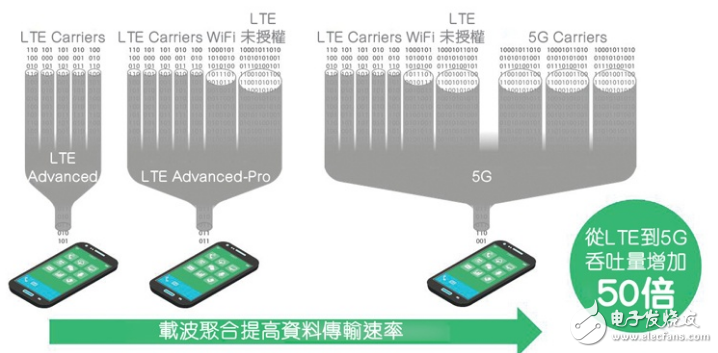Over the past 20 years, mobile phones have achieved explosive growth and become an important part of our daily lives. However, we have not yet fully grasped the complexity of mobile phones - smart phones typically use more than 10 ARM-based processors for handling touch screens, sensor processing, positioning, photography, graphics, applications, and more. A growing number of connectivity features such as Wi-Fi, Bluetooth and LTE.
As the wireless industry accelerates the standardization of the next generation of mobile broadband devices, the so-called "5G", this article will explore what this means for the technologies, challenges and use cases that will ultimately be realized. In addition, the ARM Cortex-R8 will be used as an example to explore how to implement the new mulTI-Gigabit (Gb) series products through real-time processors, while still using low power consumption as the design core.
Fast-paced mobile broadband revolution
As mobile broadband continues to change, we are seeing new use cases continue to emerge. The emergence of 5G will continue to promote the interconnected world of constant opening and constant continuity, while also changing the way humans interact with the world. Like several Gb-class services, 5G is also committed to supporting low-throughput, energy-constrained devices or so-called "massive machine-like communications" (mMTC). We see mMTC appearing in LTE today, and its standards include LTE Cat-0 and NB-IoT, both of which ensure the foundation for 5G.

When talking about 5G, the first thing people think of in their minds is the mobile device. Nowadays, the experience of smart phones is complicated enough. With the advent of 5G, what is the difference between mobile phones? Some of the proposals for discussing the 5G standard today revolve around network efficiency, focusing on how to handle the huge amount and demand for action data. Several Gb-class services allow consumers to download digital content in near-instantaneous times, while ultra-low latency connections enable new automotive applications such as virtual reality (VR) and augmented reality (AR) services.
Beyond traditional mobile phones, we see 5G as an important technology that can lead to more services. 5G will make telemedicine a reality, and physicians and healthcare workers can remotely manage patients by connecting 5G devices, a real opportunity for universal health care and physical and mental health.
A low-carbon economy may be one of the biggest challenges in achieving a developed world in the next decade. Widespread use of efficient and reliable wireless Internet will help achieve a low carbon economy because it ensures efficiency and leads to a higher degree of control and integration. From managing smart street lighting, remote emissions monitoring, public transportation and public information, 5G will bring unlimited possibilities for everyday life. Even the 5G network system architecture itself requires lower power consumption, which can reduce operating costs for mobile operators and significantly reduce carbon emissions.
In addition to being in the family, 5G can bring a new experience while driving. 5G is regarded as a technology that "beyond the mobile Internet." Its high performance and low latency make it possible to deploy traditional 4G/Wi-Fi services in areas that were previously difficult to reach. For example, connected cars or autonomous vehicles are seen as important areas where high-reliability, low-latency wireless connectivity is required for applications such as safety and collision avoidance.
Making next-generation devices possible
Spectrum is a valuable resource, and as the demand for mobile services has surged over the past decade, the demand for radio spectrum has grown. In the past, the radio spectrum was classified as "segment" or "carrier" and could be applied to different fields such as TV, Wi-Fi, Bluetooth or mobile phones. Regulators such as the Federal Communications Commission (FCC) and the UK's Communications Authority (OFCOM) allocate spectrum by region for different areas.
In the early days of the advent of mobile phones, the spectrum was divided into several intervals (usually auctioned) to provide a voice-based service—in essence, it consumes only a small amount of spectrum. Over the past decade, with the advent of smart phones, this has changed, and spectrum has become more widely used in mobile broadband services. In general, the higher the throughput provided to the user, the more spectrum is used for this service. If you multiply this number by the number of users, you will soon find that the action data is in short supply, and the traditional spectrum allocation has not kept up with this change.
So how does the entire industry keep up with the changes in delivering mobile broadband experiences, and what does this mean for the next decade's mobile technology challenges?

Carrier Aggregation (CA) coupled with advanced antenna technology called Multiple Input Multiple Output (MIMO) can be used to help relieve stress and provide more efficient service. From 3G systems to LTE, we see data rates continue to increase, although this part of the results come from more complex modulation and MIMO technology, but the increase in throughput mainly benefits from the progress of carrier aggregation, making it more efficient Use segmented spectrum.

A licensed band is a portion of the spectrum that is specifically limited to the use of the spectrum; for example, a spectrum interval may be limited to use by the mobile phone service and assigned to a particular mobile phone operator. The advantage of the licensed band is that the operator has full control over the spectrum of that part, thus being able to manage quality of service (QoS) and provide the corresponding services. The limitation of the licensed band is that it is an invaluable resource that cannot meet the growing demands of mobile data and the rapid increase in user base.
To overcome this limitation, operators are increasingly focusing on how to combine unlicensed bands with existing licensed band services. We are seeing more and more unlicensed bands being imported into carrier aggregation, allowing devices to simultaneously offload users to unlicensed technologies such as Wi-Fi and emerging LTE, simultaneously with user-licensed bands (usually as control channels) and unlicensed bands. . More advantages of many LTE standards in 3GPP focus on the management of these unauthorized offload technologies.
5G has good prospects, but the relevant standards have not yet been established. If it develops smoothly, then 5G will open digital services for the next 20 years, bringing new and powerful applications to our daily lives.

The core of 5G will bring new modulation mechanisms and increasingly complex MIMO technologies to maximize the efficiency of valuable spectrum resources and provide 50 times higher throughput than earlier LTE performance. The 5G concept also covers a wide frequency range, far beyond the bands seen today in LTE, due to the coordination of access technologies between the various bands and the goal of maximizing efficiency while increasing next-generation service capacity. From the sub GHz band that provides wide-area services to the regional GHz band that is widely used today in Wi-Fi, we will see widespread deployment of 5G applications.
Further, 5G can support the millimeter wave (mmWave) band that is not fully utilized above 30 Hz. These bands provide mulTI-Gbps throughput associated with 5G services. One of the shortcomings of the millimeter wave band is that we can only expect the device to operate within a few tens of meters of the "line of sight" and the base station, which will inherently pose challenges for deployment.
So, what does all this mean for the future of smart phones? Especially for modem baseband processing? Looking back at these trends, we note that SoC designers face three major challenges in meeting new requirements:
· Data rate continues to rise In the near future, we can expect to see LTE-based Gb-class services and up to 10-20 Gbps throughput in 5G
• Carrier aggregation significantly increases throughput and network capacity will ultimately be provided by increasingly complex carrier aggregation. The aggregation of the modem processor of the mobile phone has a high processing complexity because it must provide multiple radio access bearers in parallel. This theme will continue to be the key to the evolution of LTE technology (LTE-Advanced Pro) and 5G technology.
· Continuously promote energy efficiency and battery life for mobile devices. With the introduction of new access technologies, but not impacting or compromising the user experience, the power of the modem design must be placed at the heart of the design.
The ARM Cortex-R8 processor will be used as an example to discuss how it can help designers meet these needs. While supporting the backward compatibility of previous generations of 3G and LTE technologies, it also supports traditional technologies for continuous use in today's multimode. In the device.
POWER UNITS FOR WHARF LEVELER
Hydraulic Power Unit For Warehousing,Closed Center Hydraulic Valve,Energy Hydraulic Valve Parts,Air Operated Hydraulic Valve
CHANGZHOU ROHN HYDRAULIC SCI-TECH CO.,LTD , https://www.rohnhydraulic.com